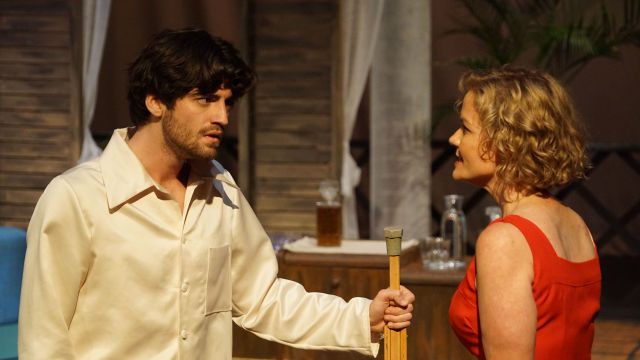Cat on a Hot Tin Roof.
It is the birthday of “Big Daddy” Pollitt, the multimillionaire owner of Mississippi’s largest cotton plantation. Ida “Big Mama” Pollitt, his wife, is celebrating the news of Big Daddy’s negative results from cancer tests.
To their son Brick and his wife Maggie, though, in their suite upstairs from the imminent celebrations, celebration seems inappropriate. Maggie tries everything to interest her alcoholic husband in her, but Brick maintains a hostility to her — and a corresponding fondness for drink — evidently born of his perception of Maggie’s role in his best friend’s death. It is Maggie herself who communicates the frustration of her ardour, her affections, and her need for intellectual companionship by invoking the image of a cat on a hot tin roof. But Brick remains sturdily impervious to all but the need to have alcohol obliterate his cares.
Meanwhile, Brick’s avaricious brother, Gooper, and his even more avaricious wife, Mae, are doing their level best — Gooper rather more subtly than Mae — to undermine all reason for Big Daddy to leave the plantation to Brick. But Maggie is having none of it.
Expressing concern over ideas that had mattered to the playwright throughout his life, Tennessee Williams’s Cat on a Hot Tin Roof highlights society’s habitual vaunting mendacity, indiscriminate fecundity, and unscrupulous ambition over truthfulness. When the play’s climactic scene, a confrontation between Big Daddy and Brick, results in their first frankly truthful conversation, everything is overturned.

The extraordinary success of the play in 1955–56 and of the film, starring Paul Newman and Elizabeth Taylor, in 1958, reflects widespread recognition of the play’s themes — recognition reflecting the reasons it won three major literary prizes, including a Pulitzer. Most of a century later, Cat on a Hot Tin Roof remains as relevant to society’s continuing bedazzlement by every convenient mendacity.
Under Anne Somes’s able direction, REP’s treatment has brought to life the subtleties that make communication sincere and the insincerities that render it worthless. The characters’ interactions reflected seemingly genuine conflicts of interest or personality, illuminated present and past misunderstandings, and ravelled and unravelled the plot with finesse.
Such a powerful play demands clear and visionary direction in order to elicit the most from its cast. That clear and visionary direction was evident in masterful performances all round. With the help of great costuming, evocative sound effects and offstage dialogue, REP’s usual perfect lighting, and a surprisingly useful single set, REP’s production of Cat on a Hot Tin Roof evoked the entire range of emotions and thoughts that its author intended so long ago.
John P. Harvey
Images: [top, L–R] Teig Sadhana and Victoria Tyrrell Dixon, and [lower, L–R] Michael Sparks OAM and Liz St Clair Long, in Cat on a Hot Tin Roof. Photographer: Helen Drum.
Subscribe to our E-Newsletter, buy our latest print edition or find a Performing Arts book at Book Nook.

